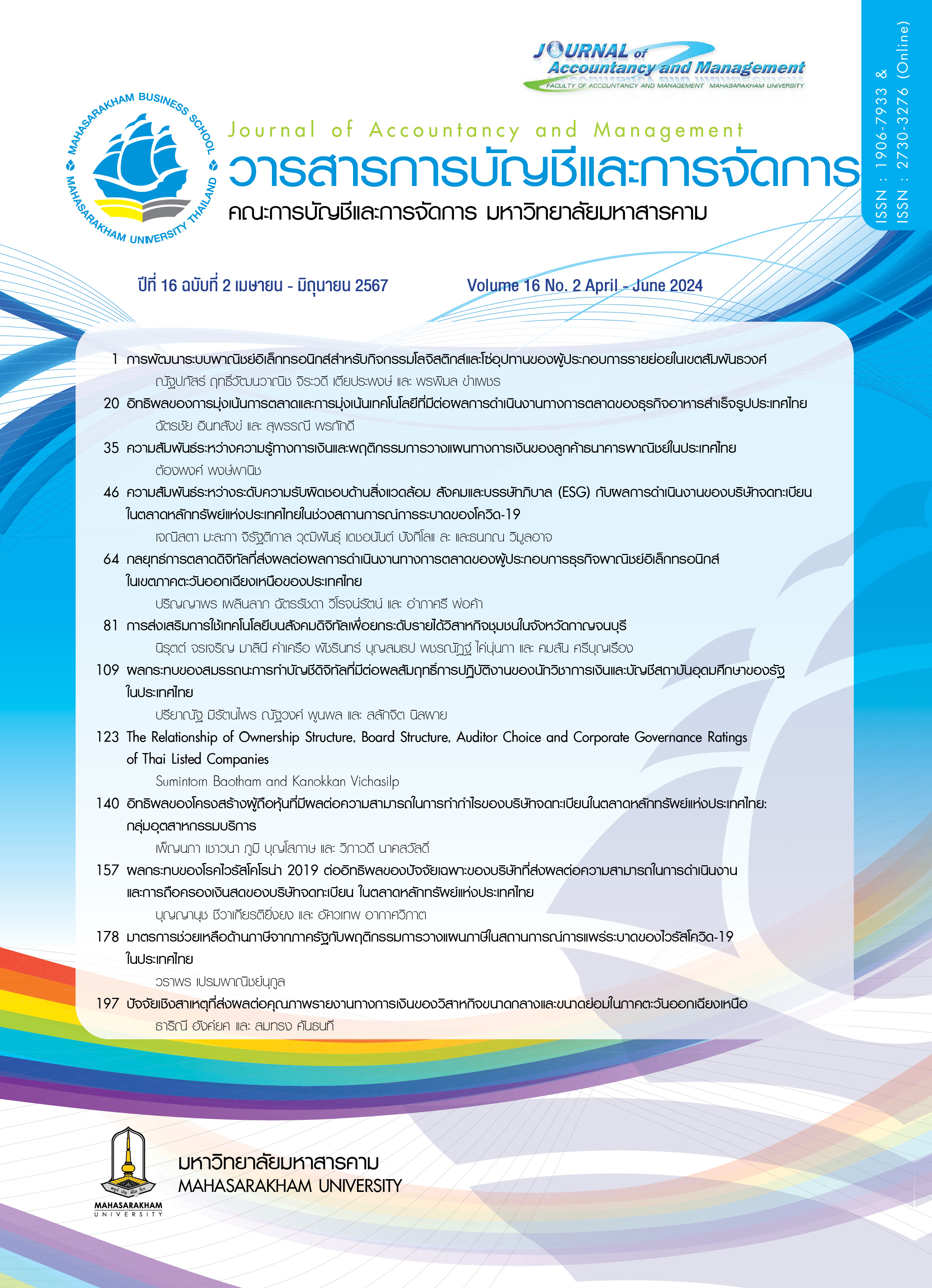การพัฒนาระบบพาณิชย์อิเล็กทรอนิกส์สำหรับกิจกรรมโลจิสติกส์และโซ่อุปทานของผู้ประกอบการรายย่อยในเขตสัมพันธวงศ์
Main Article Content
บทคัดย่อ
บทความวิจัยนี้มีวัตถุประสงค์ 1) ศึกษาข้อมูลความเป็นไปได้เกี่ยวกับการพัฒนาระบบพาณิชย์อิเล็กทรอนิกส์สำหรับกิจกรรมโลจิสติกส์และโซ่อุปทานของผู้ประกอบการรายย่อยในเขตสัมพันธวงศ์ 2) ออกแบบ พัฒนา และสร้างระบบการวางแผนจัดการห่วงโซ่อุปทานระหว่างผู้วิจัย นักพัฒนาระบบและผู้ประกอบการรายย่อย สำหรับใช้งานจริง
ในธุรกิจ 3) ติดตามและประเมินผลการใช้งานระบบการวางแผนจัดการห่วงโซ่อุปทาน สำหรับใช้จริงในธุรกิจของผู้ประกอบการรายย่อยในเขตสัมพันธวงศ์ กลุ่มตัวอย่างคัดเลือกแบบเฉพาะเจาะจงและตามเกณฑ์ผู้วิจัย วิธีวิจัยตามขั้นตอนวงจรการพัฒนาระบบ SDLC 3 ระยะ ได้แก่ ระยะ 1 กำหนดปัญหาและศึกษาความเป็นไปได้ จัดสัมมนากลุ่มย่อย 11 คน กลุ่มใหญ่ 36 คน อบรมเชิงปฏิบัติการ 55 คน เครื่องมือ คือ หัวข้อการประชุม แบบสำรวจความพึงพอใจ พบปัญหา อุปสรรค และความต้องการในการพัฒนาระบบ ผลสำรวจความพึงพอใจในการเข้ารับการอบรมอยู่ในระดับดีมาก ระยะ 2 การวิเคราะห์ ออกแบบและพัฒนาระบบ เครื่องมือ คือ หัวข้อสำหรับการประชุม ผู้เข้าร่วมประชุม 7 คน พบว่า รูปแบบระบบที่พัฒนาขึ้นมาประกอบไปด้วย การซื้อ การขาย สินค้าคงคลัง ฐานข้อมูล รายรับ รายจ่าย ที่มีการเชื่อมโยงข้อมูลกัน และออกมาเป็นระบบ TSRI & RMUTR Systems for Small Entrepreneurs สำหรับใช้งานจริงในธุรกิจ ระยะ 3 ทดสอบและประเมินผล เครื่องมือ คือ แบบสัมภาษณ์เชิงลึก พบว่า ภายหลังการส่งมอบระบบมีการติดตามและปรับปรุงระบบให้เหมาะสมกับการใช้งาน ผลการประเมินจากการสัมภาษณ์เชิงลึก 12 คน พบว่า ระบบมีข้อดีในเรื่องประโยชน์และประสิทธิภาพการใช้งาน ข้อเสียคือธุรกิจบางประเภทใช้งานระบบได้ไม่เต็มที่ ข้อเสนอแนะให้มีการปรับปรุงพัฒนาการใช้งานให้เหมาะกับธุรกิจหลากหลายประเภท
Downloads
Article Details

อนุญาตภายใต้เงื่อนไข Creative Commons Attribution-NonCommercial-NoDerivatives 4.0 International License.
บทความที่ได้รับการตีพิมพ์เป็นลิขสิทธิ์ของวารสารการบัญชีและการจัดการ
ข้อความที่ปรากฏในบทความแต่ละเรื่องในวารสารวิชาการเล่มนี้เป็นความคิดเห็นส่วนตัวของผู้เขียนแต่ละท่านไม่เกี่ยวข้องกับมหาวิทยาลัยมหาสารคาม และคณาจารย์ท่านอื่นๆในมหาวิทยาลัยฯ แต่อย่างใด ความรับผิดชอบองค์ประกอบทั้งหมดของบทความแต่ละเรื่องเป็นของผู้เขียนแต่ละท่าน หากมีความผิดพลาดใดๆ ผู้เขียนแต่ละท่านจะรับผิดชอบบทความของตนเองแต่ผู้เดียว
เอกสารอ้างอิง
กรรณริน จุลรอด. (2562). สภาพแวดล้อมภายนอกและภายในทางการตลาดที่มีผลต่อการตัดสินใจซื้อสินค้าแฟชั่นออนไลน์. วิทยานิพนธ์ปริญญาโทสาขาวิชาบริหารธุรกิจ มหาวิทยาลัยหาดใหญ่.
ชวณัฏฐ์ ด่านวิริยะกุล. (2560). การนำระบบพาณิชย์อิเล็กทรอนิกส์มาใช้ในธุรกิจร้านขายยา กรณีศึกษาจังหวัดนครปฐม. วิทยานิพนธ์ปริญญาโทสาขาวิชาหลักสูตรบริหารธุรกิจ มหาวิทยาลัยศิลปากร
ชัยวิทย์ ถิระวณัฐพงศ์ ศักดิ์ดา อ่างวัฒนกิจ และ ณรงค์ อนุพันธ์. (2561). ศึกษารูปแบบการนำระบบ อีอาร์พีเพื่อช่วยในการบริหารจัดการด้านโลจิสติกส์และห่วงโซ่อุปทาน สินค้าเกษตรอินทรีย์ กลุ่มวิสาหกิจชุมชนในจังหวัดจันทบุรีและจังหวัดตราด. โครงการวิจัยงบประมาณแผ่นดิน มหาวิทยาลัยราชภัฏรำไพพรรณ.
ณัฐวรรธน์ ศรีสุข. (2560). การเปลี่ยนแปลงธุรกิจค้าปลีกในยุคดิจิทัลของสังคมไร้เงินสด. วารสารนักบริหาร, 37(2), 88-101.
เทียนใจ สุทะ. (2561). การประเมินผลการใช้งานระบบบัญชีคอมพิวเตอร์ขององค์กรปกครองส่วนท้องถิ่น (e-LAAS) ขององค์การบริหารส่วนตำบลในจังหวัดเชียงใหม่. การค้นคว้าอิสระปริญญาโท สาขาวิชาการบริหารธุรกิจ มหาวิทยาลัยราชภัฏเชียงใหม่.
บัณฑิต ศรีสวัสดิ์. (2560). เทคโนโลยีสารสนเทศกับโลจิสติกส์. รายงานสืบเนื่องจากการประชุมวิชาการระดับชาติ ครั้งที่ 4 สถานบันวิจัยมหาวิทยาลัยราชภัฏกำแพงเพชร. 22 ธันวาคม 2560, 1337 - 1348.
ผู้จัดการออนไลน์. (2565). คลองโอ่งอ่างใกล้ล่มสลาย เผยภาพสุดเงียบเหงาหลังชัชชาติเป็นผู้ว่าฯ 6 เดือน. ค้นเมื่อ 12 สิงหาคม 2566. จาก https://mgronline.com/onlinesection/detail/9650000122356
ปิยะพันธ์ พิชญ์ประเสริฐ อัจฉรีย์ พิมพิมูล และ มาลีรัตน์ ขจิตเนติธรรม. (2563). องค์ประกอบของรูปแบบการเรียนรู้โดยใช้สื่อสังคมออนไลน์ตามแนวทฤษฎีการสร้างองค์ความรู้ด้วยตนเอง แนวคิดเดอะบิกซิกและกระบวนการเรียนรู้แบบกลุ่มสืบสอบ เพื่อพัฒนาทักษะด้านสารสนเทศสื่อและเทคโนโลยีในศตวรรษที่ 21 สำหรับ
นักเรียนชั้นมัธยมศึกษาตอนต้น. วารสารศึกษาศาสตร์, 30(3), 174-184.
มศารัศม์ ยิ่งดำรง. (2562). ปัจจัยที่มีผลต่อการพัฒนาผลิตภัณฑ์ (New Product Development) สำหรับธุรกิจรับจ้างผลิตในกลุ่มอุตสาหกรรมเครื่องใช้ไฟฟ้า. สารนิพนธ์ปริญญาโทสาขาการจัดการ วิทยาลัยการจัดการ มหาวิทยาลัยมหิดล.
รวิสรา ศรีบรรจง และ นันทวัน เหลี่ยมปรีชา. (2565). พฤติกรรมการซื้อสินค้าออนไลน์ของผู้บริโภคภายใต้วิถีความปกติใหม่ (New Normal) ในเขตอำเภอเมือง จังหวัดพิษณุโลก ที่มีผลต่อส่วนประสมการตลาดออนไลน์. การประชุมวิชาการระดับชาติประจำปี 2564, มหาวิทยาลัยนเรศวร พิษณุโลก.
เรือนทิพภา วงษ์ศิริ. (2559). การศึกษาและวิจัยเรื่อง การขายสินค้าออนไลน์ในปัจจุบันและนวัตกรรมใหม่ล่าสุดจากบริษัท บัซซี่บีส์ จำกัด. ปริญญาวิทยาศาสตร์บัณฑิตสาขาวิชาเทคโนโลยีสารสนเทศทางธุรกิจ คณะเทคโนโลยีสารสนเทศ สถาบันเทคโนโลยีไทย-ญี่ปุ่น.
สุรศักดิ์ พรบรรเจิดกุล. (2561). ทำไมบริษัทที่เติบโตมาก ๆ ถึงใช้ระบบโลจิสติกส์เป็นแกนหลักขับเคลื่อนธุรกิจ. กรุงเทพฯ : เซเว่นดี บุ๊ค จำกัด.
เสริมพงษ์ เนียมสกุล. (2561). การเพิ่มประสิทธิภาพการจัดการวัตถุดิบคงคลัง: กรณีศึกษา โรงงานผลิตน้ำดื่ม. วารสารสหศาสตร์ศรีปทุม ชลบุรี, 4(2), 1-14.
สำนักงานพัฒนาธุรกรรมทางอิเล็กทรอนิกส์. (2566). รายละเอียดศัพท์ชวนรู้. ค้นเมื่อ 23 กันยายน 2566. จาก https://shorturl.asia/mEDtc
วสุภัทร กุลเมือง. (2565). การพัฒนาระบบสารสนเทศเพื่อการบริหารสถาบันการอาชีวศึกษาภาคกลาง 1 สังกัดสำนักงานคณะกรรมการการอาชีวศึกษา. วารสารวิจัยวิชาการ, 6(4), 47-58.
อภิสิทธิ์ วงษ์สุวรรณ และ ฐานันดร ชาลี. (2562). การพัฒนาระบบซื้อขายเสื้อผ้าออนไลน์กรณีศึกษา ร้านอี๊ดแฟชั่น. รายงานวิจัยสาขาวิชาการจัดการคณะวิทยาการจัดการ มหาวิทยาลัยราชภัฏบุรีรัมย์.
Burgess, L., Cooper, J., & Alcock, C. (2001). The Adoption of the Web as a Marketing Tool by Reginal Tourism Associations (RTAs) in Australia. ACIS2001 Proceedings. Retrieved on June 20, 2012. from: http://aisel.aisnet.org/acis2001/9.
Djavanshir, G. R., Li, X., Luo, K., Zhang, M., Pan, W., & Yawei, H. (2017). ICT Innovations in Traditional Business: A Perspective of O2O Entrepreneurship Strategy in China. International Journal of Trade, Economics and Finance, 8(1), 12-19.
Holsapple, C. W., & Joshi, K. D. (2002). Knowledge management: A threefold framework. The Information Society, 18(2002), 47-64.
Li, X., & Wang, Q. (2007). Coordination Mechanisms of Supply Chain Systems. European Journal of Operational Research, 179(1), 1-16.
Laudon, K. C., & Laudon, J. P. (2010). Management Information Systems Managing the Digital Firm. London : Pearson Education, 86-87.
Stock, J. R., & Lambert, D. M. (2001). Strategic logistics management (Vol. 4). Boston, MA : McGraw-Hill/Irwin.
Stair. R., & Reynolds, G. (2010). Information Systems 9th ed., Course Technology. Boston, Massachusetts : Cengage Learning.
Weng, X., & Zhang, L. (2015). Analysis of O2O Model’s Development Problems and Trend.Scientific Research Publishing, 2015(7), 51-57.


